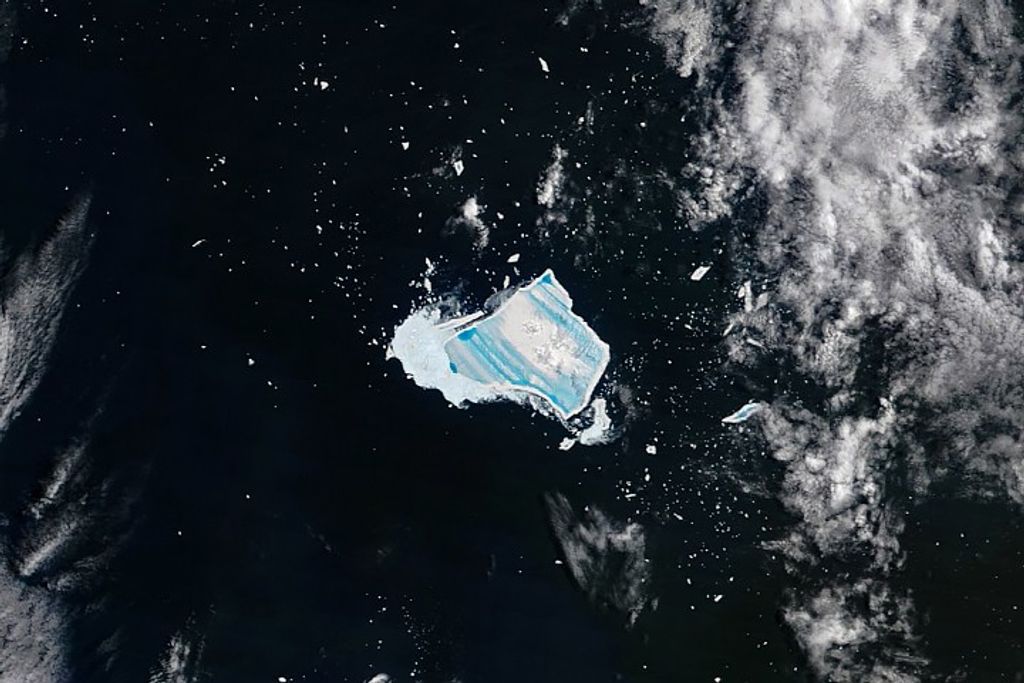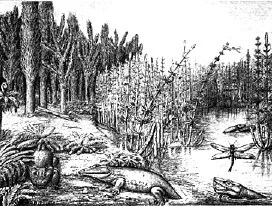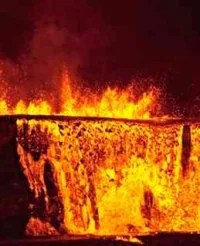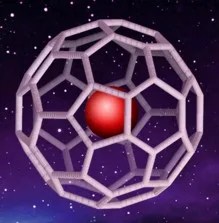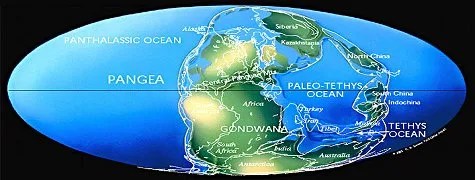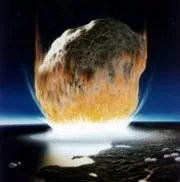250 million years ago something unknown wiped out most life on our planet. Now scientists are finding buried clues to the mystery inside tiny capsules of cosmic gas.
January 28, 2002:
It was almost the perfect crime.
Some perpetrator -- or perpetrators -- committed murder on a scale unequaled in the history of the world. They left few clues to their identity, and they buried all the evidence under layers and layers of earth.
The case has gone unsolved for years --
250 million
years, that is.
But now the pieces are starting to come together, thanks to a team of NASA-funded sleuths who have found the "fingerprints" of the villain, or at least of one of the accomplices
Above: Life was flourishing on the Earth about 250 million years ago, then during a brief window of geologic time nearly all of it was wiped out. This image is an artist's impression of a Lower Permian swamp in Texas.
The terrible event had been lost in the amnesia of time for eons. It was only recently that paleontologists, like hikers stumbling upon an unmarked grave in the woods, noticed a startling pattern in the fossil record: Below a certain point in the accumulated layers of earth, the rock shows signs of an ancient world teeming with life. In more recent layers just above that point, signs of life all but vanish.
Somehow, most of the life on Earth perished in a brief moment of geologic time roughly 250 million years ago. Scientists call it the Permian-Triassic extinction or "the Great Dying" -- not to be confused with the better-known Cretaceous-Tertiary extinction that signaled the end of the dinosaurs 65 million years ago. Whatever happened during the Permian-Triassic period was much worse: No class of life was spared from the devastation. Trees, plants, lizards, proto-mammals, insects, fish, mollusks, and microbes -- all were nearly wiped out. Roughly 9 in 10 marine species and 7 in 10 land species vanished. Life on our planet almost came to an end.
Scientists have suggested many possible causes for the Great Dying: severe volcanism, a nearby supernova, environmental changes wrought by the formation of a super-continent, the devastating impact of a large asteroid -- or some combination of these. Proving which theory is correct has been difficult. The trail has grown cold over the last quarter billion years; much of the evidence has been destroyed.
"These rocks have been through a lot, geologically speaking, and a lot of times they don't preserve the (extinction) boundary very well," says Luann Becker, a geologist at the University of California, Santa Barbara. Indeed, there are few 250 million-year-old rocks left on Earth. Most have been recycled by our planet's tectonic activity.
Undaunted, Becker led a NASA-funded science team to sites in Hungary, Japan and China where such rocks still exist and have been exposed. There they found telltale signs of a collision between our planet and an asteroid 6 to 12 km across -- in other words, as big or bigger than Mt. Everest.
Many paleontologists have been skeptical of the theory that an asteroid caused the extinction. Early studies of the fossil record suggested that the die-out happened gradually over millions of years -- not suddenly like an impact event. But as their methods for dating the disappearance of species has improved, estimates of its duration have shrunk from millions of years to between 8,000 and 100,000 years. That's a blink of the eye in geological terms.
"I think paleontologists are now coming full circle and leading the way, saying that the extinction was extremely abrupt," Becker notes. "Life vanished quickly on the scale of geologic time, and it takes something catastrophic to do that."
Such evidence is merely circumstantial -- it doesn't actually prove anything. Becker's evidence, however, is more direct and persuasive:
Deep inside Permian-Triassic rocks, Becker's team found soccer ball-shaped molecules called "fullerenes" (or "buckyballs") with traces of helium and argon gas trapped inside. The fullerenes held an unusual number of 3He and 36Ar atoms -- isotopes that are more common in space than on Earth. Something, like a comet or an asteroid, must have brought the fullerenes to our planet.
Becker's team had previously found such gas-bearing buckyballs in rock layers associated with two known impact events: the 65 million-year-old Cretaceous-Tertiary impact and the 1.8 billion-year-old Sudbury impact crater in Ontario, Canada. They also found fullerenes containing similar gases in some meteorites. Taken together, these clues make a compelling case that a space rock struck the Earth at the time of the Great Dying.
But was an asteroid the killer, or merely an accomplice?
Many scientists believe that life was already struggling when the putative space rock arrived. Our planet was in the throes of severe volcanism. In a region that is now called Siberia, 1.5 million cubic kilometers of lava flowed from an awesome fissure in the crust. (For comparison, Mt. St. Helens unleashed about one cubic kilometer of lava in 1980.) Such an eruption would have scorched vast expanses of land, clouded the atmosphere with dust, and released climate-altering greenhouse gases.
World geography was also changing then. Plate tectonics pushed the continents together to form the super-continent Pangea and the super-ocean Panthalassa. Weather patterns and ocean currents shifted, many coastlines and their shallow marine ecosystems vanished, sea levels dropped.
"If life suddenly has all these different things happen to it," Becker says, "and then you slam it with a rock the size of Mt. Everest -- boy! That's just really bad luck."
Was the "crime" then merely an accident? Perhaps so. Nevertheless, it's wise to identify the suspects -- an ongoing process -- before it happens again.
Editor's note: Becker's colleagues include Robert Poreda and Andrew Hunt from the University of Rochester, NY; Ted Bunch of the NASA Ames Research Center; and Michael Rampino of New York University and NASA's Goddard Institute of Space Sciences. Funding for the research was provided by NASA's Astrobiology and Cosmochemistry programs and the National Science Foundation.
NASA Astrobiology Institute
What happens when a 6 to 12 km space rock hits Earth? The initial blast from the impact would sweep over a large area of the planet, killing everything in its path. It would throw up millions of tons of debris to obscure the Sun, hindering the photosynthesis that drives most ecosystems. The heat would release large volumes of CO2 and SO2 from the vaporization of rocks, and ignite the world's forests -- releasing still more CO2 and inducing long-term global warming. As the atmospheric debris slowly rains back down onto the surface, toxic compounds might poison much of what life remains.
Mounting Evidence: A research team headed by Kunio Kaiho of the Tohoku University in Sendai, Japan, recently announced their measurements of sulfur isotopes in rocks from the Permian-Triassic boundary. The P-T boundary layer is enriched with "light sulfur" -- much like material from our planet's mantle. The finding suggests that some event 250,000,000 years ago (like an asteroid impact) spread material from the mantle over the surface of the land. "Their data suggest that an asteroid or comet hit the ocean and caused a rapid, massive release of sulfur and other noxious materials from the Earth's mantle to the ocean-atmosphere system," agrees Ted Bunch, a research scientist at NASA's Ames Research Center and a member of Becker's science team.
Reference: "End-Permian catastrophe by a bolide impact: Evidence of a gigantic release of sulfur from the mantle," K. Kaiho, et al., Geology, Sept. 2001, 29, 815.
Massive Volcanic Eruptions in Siberia Linked with Mass Extinction -- scientists present evidence linking the largest extinction of animals in Earth's history with rapid and extensive volcanic activity in Siberia
How did the formation of a supercontinent at the end of the Permian play a part in mass extinction?
Permian-Triassic extinction -- an article and video about the extinction, from the Public Broadcasting System
Theories of Causes of the PT extinction -- details about other theories on the cause of the extinction, including volcanism, a supernova, and climate changes.
Permian/Triassic life -- a listing of prominent types of life on Earth both before and after the great extinction. Includes pictures.
Buckyballs and Gases May Mark Massive Extinction -- an article about the fullerene evidence for an asteroid or comet impact
Join our growing list of subscribers -
sign up for our express news delivery
and you will receive a mail message every time we post a new story!!!
More
Headlines
THE END









